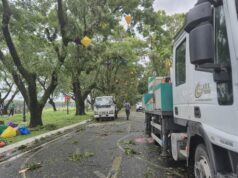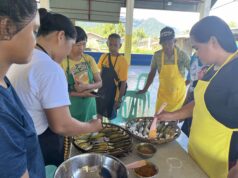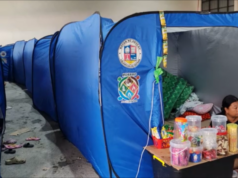(By water and land transport of people,
products, goods and services)
In last week’s Agyu Tamu Atbp article, I reported to you about the construction of the 125 kms-long Tarlac-Dingalan road in the northern part of Luzon that connects by land the South China Sea in the west of Subic, Zambales, to the Philippine Sea east of Dingalan Port, Aurora province, toward the Great Pacific.
The significance of the Tarlac-Dingalan road infra-structure is the establishment of the logistics supply chain system between the western and eastern parts of Luzon that will facilitate the transport of people, products, goods, and services by and amongst the people and communities in the areas traversed by the 125 kms.-long road, thereby promoting social and economic development therein through increased trade, commerce and industry. Along with such development will come jobs and livelihood opportunities, and, consequently, the improvement of social and economic life.
Consructing logistics infra-structure is like throwing a pebble in a quiet pond—it creates little waves around the point of impact that move outward from center growing bigger as the waves gather momentum and strength until they reach the edge of the pond.
Similar logistics infrastructures have been constructed, completed and, in fact, long been operational located in Southern Luzon. By the way, Southern Luzon is the production and manufacturing center of the Luzon Urban Beltway Super Region In my report to the President and the Cabinet last 23 February, I cited these logistics infrastructure projects, which are as follows:
• SOUTHERN TAGALOG ARTERIAL ROAD (STAR) and BATANGAS PORT DEVELOPMENT PROJECT. The STAR project is a 20-km of four-lane toll road from Lipa City to Batangas City, that was started in January 2006 and completed in March 2008, and opened on April 17, 2008. The STAR serves as the vital link of the Batangas Port (developed and completed December 2007) to the rest of the LUB Super Region. It significantly reduces travel time from Manila to Laguna and Batangas. The Batangas Port , on the other hand, is the best complement for the Port of Manila due to its strategic location. It is being developed to become a major international container terminal, with handling capacity ofn 4.34 million tons a year. Both projects are seen to play important roles in economic, social and tourism development in the CALABARZON (Cavite, Laguna, Batangas, Rizal and Quezon provinces).
• RORO PORT LINKAGE OF LUCENA, QUEZON AND BOAC, MARINDUQUE PROJECT. This project is in line with President Arroyo’s “vision of inter-connected inter-island ports through seamless nautical highway.” This roro project has three components:
1. The Lucena Port Passenger Terminal Building, located in Talao-Talao, Lucena City, which involved the construction of a two-story passenger terminal building that was started in January 2006 and completed in December of the same year;
2. The Lucena Port Improvement Project requiring the concrete paving of the back-up of the Lucena Port, which was started in January 2007 and finished in November also of the same year; and
3. The Cawit Port Development Project, located in Cawit, Boac, Marinduque, which involved the reconstruction of reinforced concrete pier, started in February 2007 and completed in November, same year.
The Roro Port Linkage of Lucena, Quezon and Boac, Marinduque, has made roll-on, roll-off service available between the two provinces, thereby facilitating seamless delivery of goods from farm to market that consequently reduces damage to crops and other goods or farm products.
The roro port project has also reduced travel and transport costs and provided faster and more secure cargo and passenger transport. Moreover, It has enhanced port operations; has paved the way for increased business opportunities by way of more efficient and effective and economical conduct of trade and commerce of goods and services; and has generated job and livelihood opportunities in the areas serviced by the roro port project operations.
In the next week’s issue of Agyu Tamu Atbp, I will report to you on the logistics infra-structures in the National Capital Region (Metro-Manila), those that have been planned, completed, or are on-going and nearing completion. The broad range of infrastructure developments now taking place in the Luzon Urban Beltwau Super Region and their total social and economic impact in the life of our people should give enough good reason to lift our hopes for better times.
I would like us to continue our conversation on this topic in my column next week. Thank you, agyu tamu, ne? Mabuhay!
products, goods and services)
In last week’s Agyu Tamu Atbp article, I reported to you about the construction of the 125 kms-long Tarlac-Dingalan road in the northern part of Luzon that connects by land the South China Sea in the west of Subic, Zambales, to the Philippine Sea east of Dingalan Port, Aurora province, toward the Great Pacific.
The significance of the Tarlac-Dingalan road infra-structure is the establishment of the logistics supply chain system between the western and eastern parts of Luzon that will facilitate the transport of people, products, goods, and services by and amongst the people and communities in the areas traversed by the 125 kms.-long road, thereby promoting social and economic development therein through increased trade, commerce and industry. Along with such development will come jobs and livelihood opportunities, and, consequently, the improvement of social and economic life.
Consructing logistics infra-structure is like throwing a pebble in a quiet pond—it creates little waves around the point of impact that move outward from center growing bigger as the waves gather momentum and strength until they reach the edge of the pond.
Similar logistics infrastructures have been constructed, completed and, in fact, long been operational located in Southern Luzon. By the way, Southern Luzon is the production and manufacturing center of the Luzon Urban Beltway Super Region In my report to the President and the Cabinet last 23 February, I cited these logistics infrastructure projects, which are as follows:
• SOUTHERN TAGALOG ARTERIAL ROAD (STAR) and BATANGAS PORT DEVELOPMENT PROJECT. The STAR project is a 20-km of four-lane toll road from Lipa City to Batangas City, that was started in January 2006 and completed in March 2008, and opened on April 17, 2008. The STAR serves as the vital link of the Batangas Port (developed and completed December 2007) to the rest of the LUB Super Region. It significantly reduces travel time from Manila to Laguna and Batangas. The Batangas Port , on the other hand, is the best complement for the Port of Manila due to its strategic location. It is being developed to become a major international container terminal, with handling capacity ofn 4.34 million tons a year. Both projects are seen to play important roles in economic, social and tourism development in the CALABARZON (Cavite, Laguna, Batangas, Rizal and Quezon provinces).
• RORO PORT LINKAGE OF LUCENA, QUEZON AND BOAC, MARINDUQUE PROJECT. This project is in line with President Arroyo’s “vision of inter-connected inter-island ports through seamless nautical highway.” This roro project has three components:
1. The Lucena Port Passenger Terminal Building, located in Talao-Talao, Lucena City, which involved the construction of a two-story passenger terminal building that was started in January 2006 and completed in December of the same year;
2. The Lucena Port Improvement Project requiring the concrete paving of the back-up of the Lucena Port, which was started in January 2007 and finished in November also of the same year; and
3. The Cawit Port Development Project, located in Cawit, Boac, Marinduque, which involved the reconstruction of reinforced concrete pier, started in February 2007 and completed in November, same year.
The Roro Port Linkage of Lucena, Quezon and Boac, Marinduque, has made roll-on, roll-off service available between the two provinces, thereby facilitating seamless delivery of goods from farm to market that consequently reduces damage to crops and other goods or farm products.
The roro port project has also reduced travel and transport costs and provided faster and more secure cargo and passenger transport. Moreover, It has enhanced port operations; has paved the way for increased business opportunities by way of more efficient and effective and economical conduct of trade and commerce of goods and services; and has generated job and livelihood opportunities in the areas serviced by the roro port project operations.
In the next week’s issue of Agyu Tamu Atbp, I will report to you on the logistics infra-structures in the National Capital Region (Metro-Manila), those that have been planned, completed, or are on-going and nearing completion. The broad range of infrastructure developments now taking place in the Luzon Urban Beltwau Super Region and their total social and economic impact in the life of our people should give enough good reason to lift our hopes for better times.
I would like us to continue our conversation on this topic in my column next week. Thank you, agyu tamu, ne? Mabuhay!




